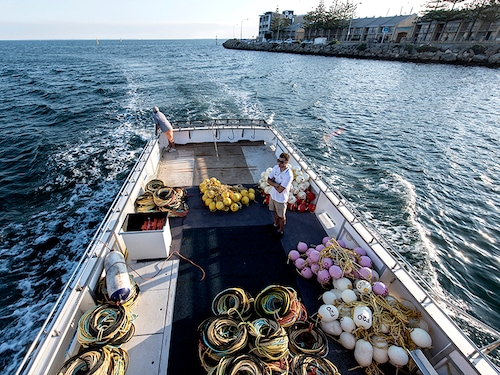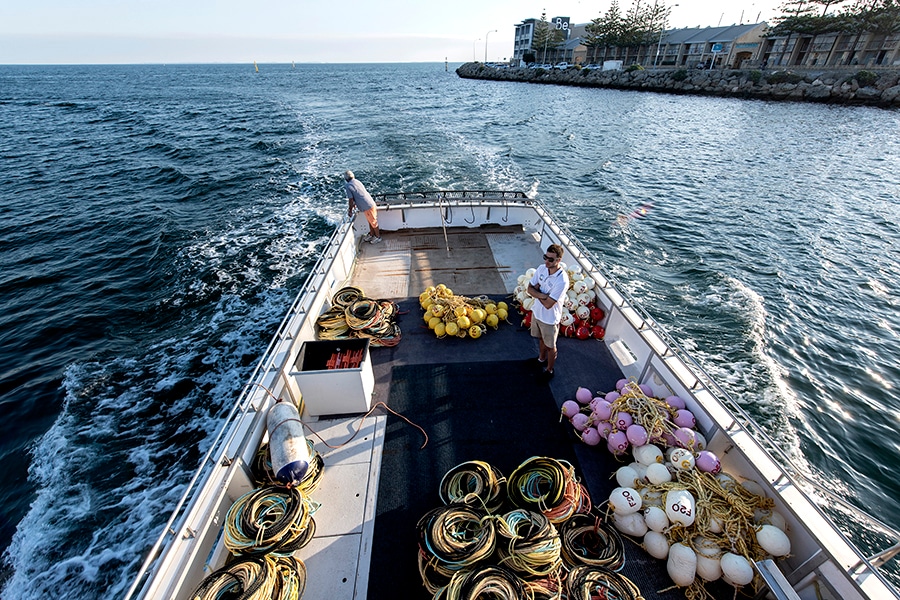Can we really break the China habit?
The risks of relying economically on the Asian superpower have never seemed clearer. But as the world tries to get moving again, it needs China more than ever


 Giacomo Camarda, left, and James Camarda, rock lobster fishermen, work near Fremantle, Australia, April 29, 2020. Australia’s lobstermen are almost entirely reliant on China: By the beginning of this year, 95% of their catch was shipped there. (David Dare Parker/The New York Times)
Giacomo Camarda, left, and James Camarda, rock lobster fishermen, work near Fremantle, Australia, April 29, 2020. Australia’s lobstermen are almost entirely reliant on China: By the beginning of this year, 95% of their catch was shipped there. (David Dare Parker/The New York Times)
As the coronavirus pandemic amplifies long-standing concerns over the world’s economic dependence on China, many countries are trying to reduce their exposure to Beijing’s brand of business.
Japan has set aside $2.2 billion to help companies shift production out of China. European trade ministers have emphasized the need to diversify supply chains. Several countries, including Australia and Germany, have moved to keep China, among others, from buying businesses weakened by lockdowns. Hawks in the Trump administration also continue to press for an economic “decoupling” from Beijing.
But outside government circles, in the companies where the decisions about manufacturing and sales are actually made, the calculations are more complex.
China is a hard habit to break.
Even after its early mishandling of the coronavirus disrupted the country’s ability to make and buy the world’s products, further exposing the faults of its authoritarian system and leading it to ratchet up its propaganda war, China’s economic power makes it the last best hope for avoiding a protracted global downturn.
“When this all started, we were thinking, Where else can we go?” said Fedele Camarda, a third-generation lobster fisherman in western Australia, which sends most of its catch to China. “Then the rest of the world was also compromised by the coronavirus, and China is the one getting back on its feet.”
“Although they’re just one market,” he added, “they’re one very big market.”
To understand how businesses are responding to the shifting dynamics and risks, The New York Times profiled three companies in three countries that are heavily reliant on China. Their experiences vary, but they are all trying to work out just how much of a breakup with China is needed — or whether they can afford one.
Beg to Return: Australia’s lobster boats
When Camarda fished for lobster off Australia’s west coast in the 1990s, his catch ended up on plates in a variety of countries.
Fresh crays, as the lobsters are known, went to Japan. Canned lobster meat went to the United States. The rest was sold inside Australia or to its nearest neighbors.
But starting around 2000, China began paying more for live lobsters, and ordering more. That led to a near-total reliance on that market and a sense of complacency: By the beginning of this year, 95% of Australia’s spiny lobsters were being shipped to sellers and restaurants in China.
“We all talked about different strategies to overcome the problem, to not be so reliant on China,” Camarda said. “We just didn’t get around to it.”
And they still haven’t, even after the need for diversification hit like a hammer on Jan. 25.
That’s when China, in the midst of its outbreak, stopped buying. Officials shut down the wet markets that sell fresh meat, vegetables and seafood, forcing the entire fleet of lobster boats up and down Australia’s west coast — all 234 — to stop fishing. More than 2,000 people found themselves without work.
Australia’s lobster processors tried to quickly diversify, calling buyers in every country they had ever worked with, reaching back to contacts from decades earlier. The industry association pleaded with the Australian government for help: requesting a larger quota for the year, an extension of the season and more freedom to sell directly to the public, all of which were approved by fisheries managers.
But none of it did much good for Camarda. While certain food exports to China from other parts of the world increased — chicken meat from Brazil, for example — only a few boats went out in February, March and April, pulling in very little.
Camarda returned to the water only about a month ago. Orders to his company, Neptune 3, are starting to come in again from China, at prices that are roughly half what they were in January. The orders aren’t anywhere near as large, either, but the industry has coalesced around trying to rebuild its ties with China, rather than looking elsewhere.
“Even if prices are low and the amount of product is down, we need to find a way to service that market, because providing that market is what works for us,” said Matt Taylor, the chief executive of Western Rock Lobster, the industry’s professional association.
As of about a month ago, there was still one major challenge: shipping. Supply chains had been scrambled, as passenger planes that carry much of the world’s cargo have been idled and shipping has decreased. So once again the Australian government stepped in, this time with around $70 million to subsidize charter flights for seafood exports.
Despite calls for greater self-sufficiency, diversification and sovereignty, as well as moves by China that have hurt barley and beef exports, Australia is not running away from the Chinese market. It is subsidizing efforts to get back in.
No Savior: Germany’s China optimism wanes
The last time German industry faced a severe downturn, relief came from China. The country’s explosive growth and hunger for Western technology helped German exporters bounce back quickly from the deep recession a decade ago.
“In 2008, there were two markets that I ran to: China and the Middle East,” said Olaf Berlien, chief executive of Osram, one of the world’s largest lighting companies, which is based in Munich.
But he does not expect Chinese sales to save German industry again.
“China is still a market,” Berlien said, “but it’s not a growth market.”
Osram had turned bearish on China even before the coronavirus forced the country into quarantine. Car sales were down in 2019 after years of double-digit growth, largely because of the trade war with the U.S.
The problem is that there is no other market to take China’s place as an engine of world growth. India has potential, but is too disorganized, Berlien said. Middle Eastern countries like Saudi Arabia and Qatar are no longer as wealthy now that oil prices have collapsed.
Osram’s diminished expectations for China reflect a deepening skepticism across Europe about the benefits of turning to the Asian superpower in times of need. Phil Hogan, the European Union trade commissioner, echoed the concerns of officials in Germany and France when he called in April for a discussion “on what it means to be strategically autonomous.”
Osram, which provides lights for cars and other uses, didn’t need the nudge. It has four factories in China, Berlien said, but the company manufactures its more sophisticated products in Malaysia, Germany and the U.S. because of China’s lack of protection for intellectual property.
“China is no longer the workbench of the world,” he said.
Berlien said that his company and others in Germany had learned from past crises to insure themselves against supply chain disruptions, by taking steps like having at least two suppliers of every component or raw material.
He added that while Osram had no plans to reduce its presence in China, the coronavirus crisis would prompt companies to look harder for suppliers closer to home.
“What we are all learning, and I talk to a lot of managers and CEOs in Germany, is that we all have to rethink our logistics and supply chains,” Berlien said.
“They were very fragmented and very vulnerable,” he added. “Because of the price pressure that we are all under, we took the cheapest provider wherever in the world it might have been. We undervalued the provider who was just around the corner.”
Stay the Course: Japan’s luxury toilets
Toto makes what China’s nouveau riche really want: electronic bidet toilets with heated seats, warm water jets, pleasingly shaped ceramic bowls and automated lids.
The company, Japan’s largest toilet maker, opened its Beijing office in 1985, and its reliance on China has grown along with the country’s rise. China accounted for half of Toto’s overseas sales last year, and it has seven factories in the country.
But even after China’s lockdown closed Toto’s assembly lines in January and February, the company never considered leaving.
For one thing, it’s a huge market with a high rate of homeownership and rising disposable incomes. For another, many of its workers have the kinds of technical skills that Toto needs.
“China is close to Japan, and it has the power of a lot of people,” said Sonoko Abe, a Toto spokeswoman.
In daily meetings, executives discussed “how we can adjust to the situation,” Abe said. Although the company has plants in Thailand and Vietnam, it did not try to shift production, but instead relied on a pipeline of stored inventory.
Many other Japanese companies, even when there are incentives to look elsewhere, are stepping away from China only slowly, if at all.
Japanese mask-maker Iris Ohyama, for example, has factories in Dalian and Suzhou that produce goods for both the Chinese and Japanese markets. It is drawing on some of the government’s funding to open new factory lines in Japan to accommodate the domestic market, and is exploring options in France and the U.S.
But it has no plans to stop manufacturing in China. “We think the Chinese market is very important in the long run,” said Atsuko Kido, a spokeswoman.
It is also important right now: The International Monetary Fund has reported that China will be one of the few countries to see economic growth in 2020, while the U.S. economy is expected to contract by about 6% and the eurozone by 7.5%.
Kathy Matsui, chief Japan equity strategist at Goldman Sachs in Tokyo, said that in a time of severe economic pressure, even those who oppose China’s politics feel that they need the country’s economy to prosper.
“We are all interconnected,” she said. “So it’s vital that China continues to grow for pretty much every major economy around the world.”
First Published: Jun 15, 2020, 11:57
Subscribe Now